
Email is still a vital tool for productivity and communication in the modern digital world. Gmail vs Outlook are two of the most popular email platforms in the world, each offering its own unique interface and ease of use.
The choice between these two can be a tough decision. In this comparison, we’ll explore the key differences between these two email platforms in their interfaces, customization, search features, integration capabilities, mobile apps, and productivity tools, helping you make an informed choice for your email needs.
Let’s explore the characteristics of each and compare their user experiences.
Table of Content
Interface
Gmail’s User Interface: Streamlined Simplicity
When it comes to email interfaces, Gmail’s user interface has long been celebrated for its remarkable simplicity and user-friendliness. The interface takes a minimalist approach, prioritizing efficient email management.
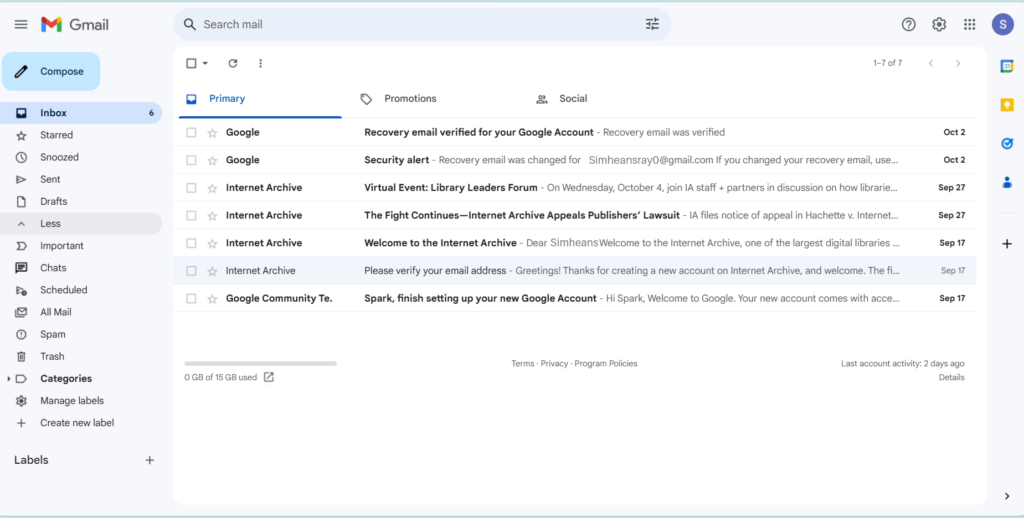
The inbox, a cornerstone of the user interface, boasts a clean layout, making email access effortless.
The left-hand sidebar, a pivotal aspect of the interface, offers swift access to essential features, including a highly efficient search bar, user-friendly labels, and easily navigable folders. This design, with a keen focus on productivity, contributes to Gmail’s enduring popularity.
Outlook’s User Interface: Professional Efficiency
In stark contrast, Outlook’s user interface adopts a more professional and business-centric design philosophy.
The interface introduces users to a concept known as the focused inbox, a central element of the user interface that aims to streamline email management by highlighting essential messages.
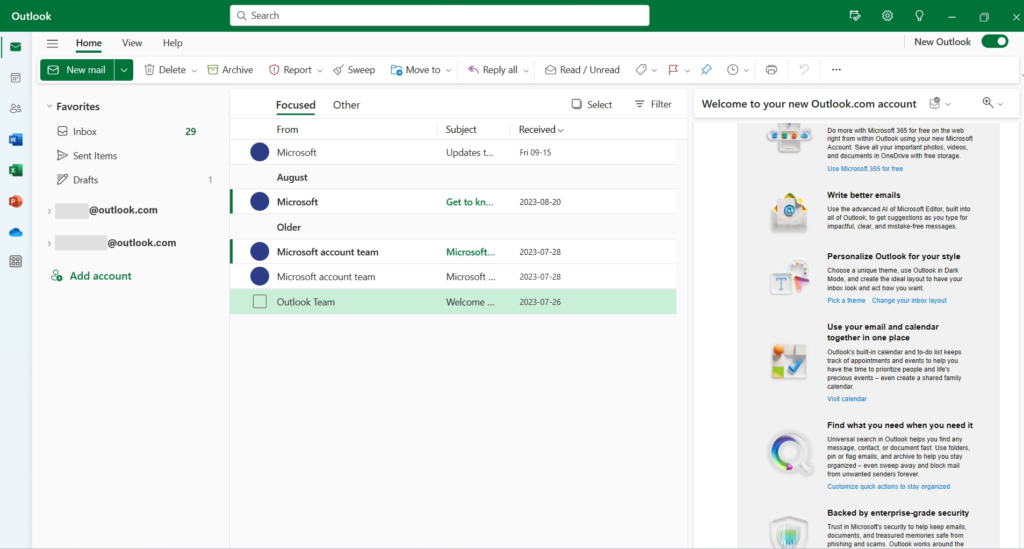
Navigation within the interface is simplified, relying on a vertical menu located on the left side to provide quick access to email folders and functions.
The overall appearance of the interface exudes professionalism, aligning seamlessly with the trusted Microsoft brand image.
In this in-depth comparison of Gmail vs. Outlook interface, these distinctive design choices play a vital role in shaping user preferences and experiences.
Features
Gmail is a popular email client known for its free and paid versions. The free version comes with ads, while the paid option, for Business (now part of Google Workspace), offers additional features and customization options.
One of the standout features is its robust search functionality, making it effortless to find specific emails quickly. It uses labels and filters to help users efficiently organize and categorize their emails.
Additionally, it seamlessly integrates with other Google services such as Google Calendar, Google Drive, Google Contacts, Google Notes and Google Task enhancing productivity for users in the Google ecosystem.

It has spam filtering capabilities that are highly effective, automatically identifying and filtering out most unwanted emails. The platform also offers chat and video call features through Google Chat and Google Meet, allowing users to communicate in real time without leaving their email interface.

Conversation view groups related emails into threads, simplifying email tracking and management.
Moreover, it provides offline access, ensuring that users can access their emails even when an internet connection is not available. Large attachments can be sent and received through Google Drive integration, facilitating the sharing of files and documents.
On the other hand, Outlook is closely integrated with the Microsoft ecosystem, making it an excellent choice for users who rely heavily on Microsoft Office 365 and OneDrive.
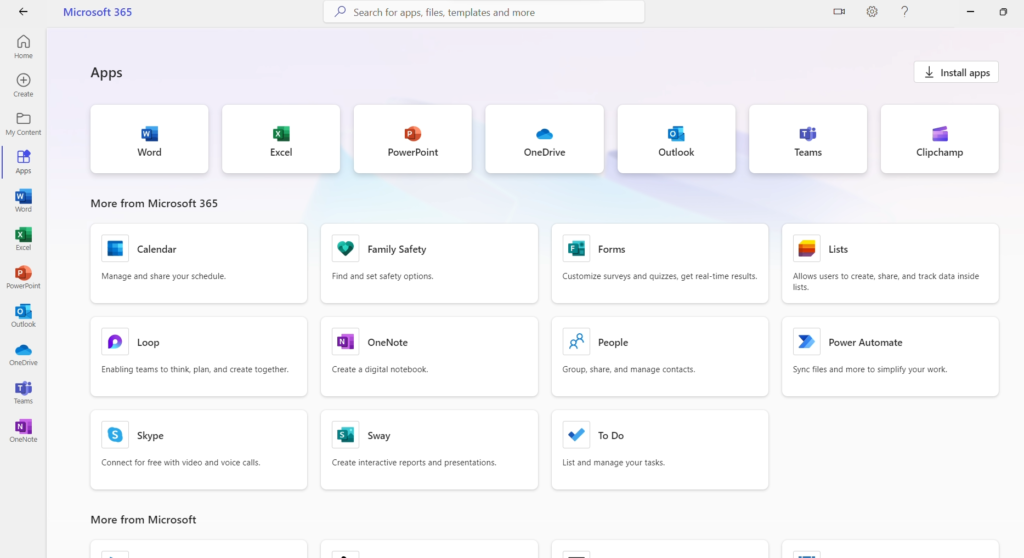
It offers robust calendar features, including scheduling, meeting invitations, and seamless integration with Microsoft Teams for video conferencing.
A notable feature in Outlook is the Focused Inbox, which automatically separates important emails from less critical ones, streamlining email management.
It includes task management features, allowing users to create to-do lists and set reminders, improving organization and productivity. It also offers extensive customization options, such as email rules, categories, and quick steps, enabling users to tailor their email experience to their preferences.
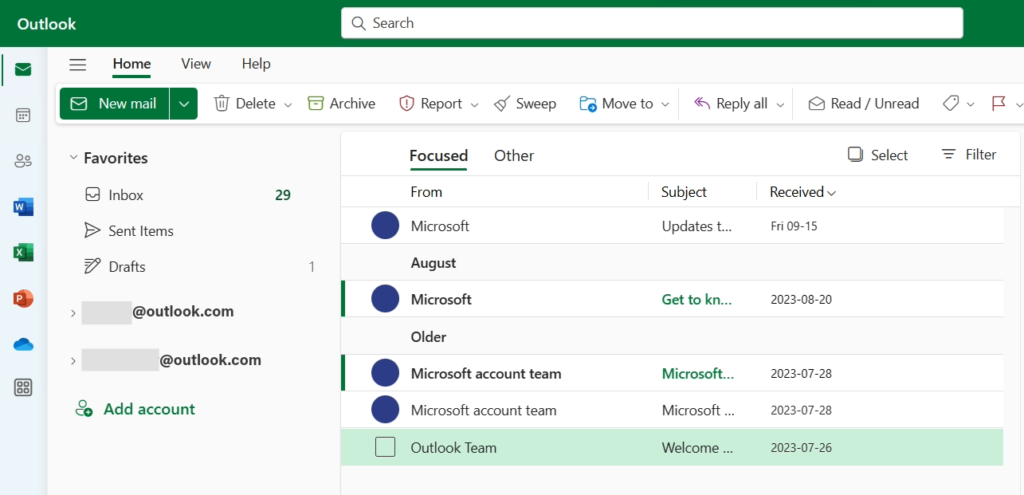
Email templates save time when composing repetitive messages, and the scheduling assistant helps users find optimal meeting times when dealing with multiple participants.
Additionally, it supports unified inboxes, making it possible to manage multiple email accounts from a single interface.
Microsoft prioritizes security, offering features such as email encryption and multi-factor authentication to protect sensitive information. It also integrates with various third-party apps and services, expanding its functionality and usability.
Compatibility and Integration
Gmail offers a comprehensive suite of integration options, making it a versatile email client. Its Google Services Integration is a standout feature, providing seamless connectivity with Google Calendar, Google Drive, Google Contacts, and Google Chat.

This means that within Gmail, users can easily manage their schedules, access files, communicate with contacts, and even engage in real-time chats.
Additionally, it supports an extensive range of Third-party App Integration through the Google Workspace Marketplace. Users can enhance their experience by adding various third-party extensions and apps for tasks like project management, CRM, and email tracking.
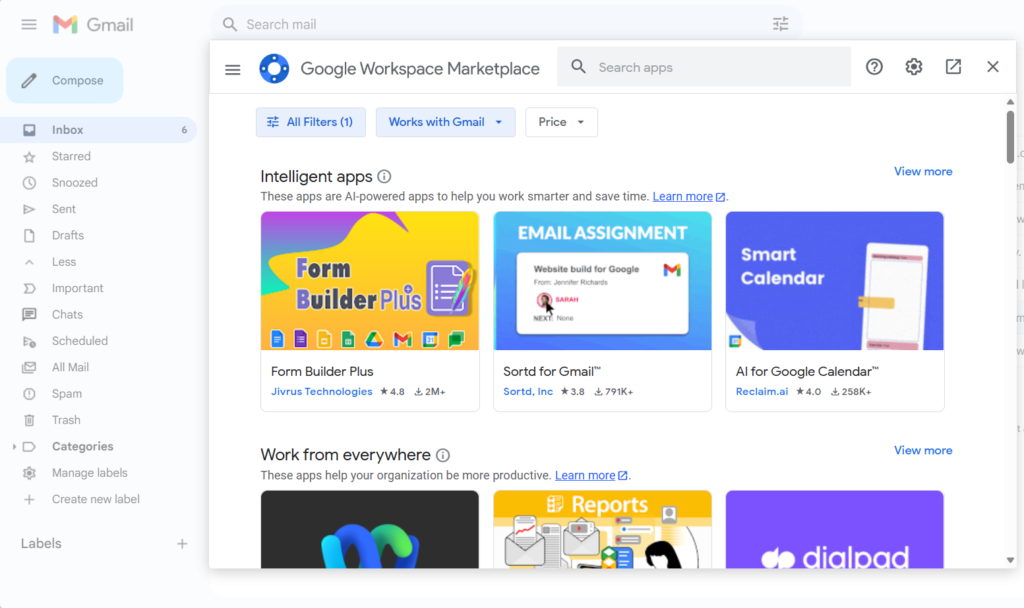
For users on the go, it provides Mobile Compatibility with dedicated apps for Android and iOS devices, ensuring a consistent email experience across mobile platforms.
On desktops, it’s compatible with popular web browsers like Google Chrome, Mozilla Firefox, Safari, and Microsoft Edge.
It also supports standard email protocols like IMAP and POP3, allowing users to configure their Gmail accounts on third-party email clients, enhancing its Web Browser Compatibility.
Outlook shines in its integration within the Microsoft ecosystem. The Microsoft Ecosystem Integration allows seamless access to Microsoft 365 applications such as Word, Excel, PowerPoint, and OneDrive directly from the email interface.

This robust integration enables efficient document collaboration and sharing within emails. It has strong Exchange Server Compatibility is another noteworthy feature, making it a preferred choice for businesses relying on Exchange for email and calendaring services.
For users on mobile devices, it offers dedicated Mobile Compatibility with apps for Android and iOS, ensuring access to email and calendars while on the move.
It also provides web browser access, allowing users to access their accounts from various platforms and devices. In addition to its native features, it also supports Third-party App Integration through add-ins available in the Microsoft AppSource.
These add-ins expand Outlook’s functionality, allowing users to customize their email experience with productivity and collaboration tools.
Pros and Cons of Gmail vs Outlook
Discover the pros and cons of making an informed choice. From cost and user-friendliness to integration and limitations, let’s explore which email platform suits you best.
Pros
| Aspect | Gmail | Outlook |
| Storage | ⭐⭐⭐⭐⭐ Generous free storage (15 GB) for emails and attachments. | ⭐⭐⭐⭐Free storage (5 GB). Offering ample storage for subscribers. |
| Search | ⭐⭐⭐⭐Powerful search functionality. | ⭐⭐⭐Effective search capabilities, including Focused Inbox. |
| Integration | ⭐⭐⭐Seamless integration with Google services. | ⭐⭐⭐⭐Deep integration with Microsoft ecosystem. |
| Spam Filtering | ⭐⭐⭐⭐Robust spam filters. | ⭐⭐⭐Effective spam filters and security features. |
| Offline Access | ⭐⭐⭐Allows offline access to emails and attachments. | ⭐⭐⭐Offline access for certain plans, enhancing accessibility. |
Cons
| Aspect | Gmail | Outlook |
| Ad-Supported (Free) | ⭐⭐The free version includes ads, which can be distracting. | ⭐⭐Free version of Outlook also includes ads. |
| Learning Curve | ⭐⭐⭐Interface and features can be complex for beginners. | ⭐⭐⭐⭐Outlook’s interface may feel overwhelming for some users. |
Pricing and Plans
Both offer free versions with ample storage for general users. Gmail provides paid plans for enhanced features and increased storage, catering to individuals and businesses. In contrast, Outlook’s paid plans include access to the full Microsoft suite and are ideal for those seeking comprehensive email and productivity solutions.
| Aspect | Gmail | Outlook |
| Pricing Plans | Free version available. Paid plans for additional features. | Free version available. Paid plans for additional features. |
| Storage | 15 GB free. Paid plans | 15 GB free. Paid plans |
| Additional Features | Integrated productivity tools | Integrated productivity tools |
| Integration | Seamless integration with Google & third-party services. | Integration with Microsoft services & third-party services. |
Check Price
Customer Support
Gmail Customer Support: Responsive Help
It offers responsive assistance through various channels, including email and chat. Their extensive knowledge base is a valuable resource for addressing common queries and issues, ensuring users have access to the help they need.
Outlook Customer Support: Robust Assistance
Similarly, it provides robust customer support, featuring an accessible knowledge base and responsive email and chat support. This multi-tiered support approach enhances the overall user experience by promptly addressing user queries and issues.
In comparing customer support, both services prioritize user satisfaction through a range of support options, including knowledge bases and responsive assistance channels. This commitment to customer support contributes to an enhanced user experience.
Conclusion
In the end, deciding between Gmail and Outlook comes down to what works best for you. Gmail is a good choice if you want something simple and inexpensive. On the other hand, if you value a professional appearance and integration with Microsoft tools, Outlook could be the way to go.
Consider your priorities, whether they are flawless Google experience or full Microsoft integration and make your choice accordingly. Both services have their own Pros and Cons, so it’s about finding the one that best suits your needs.